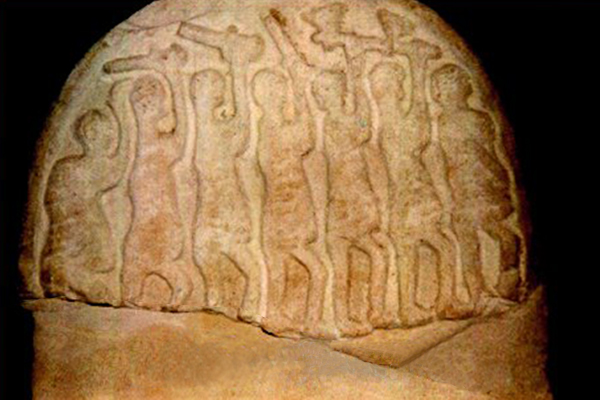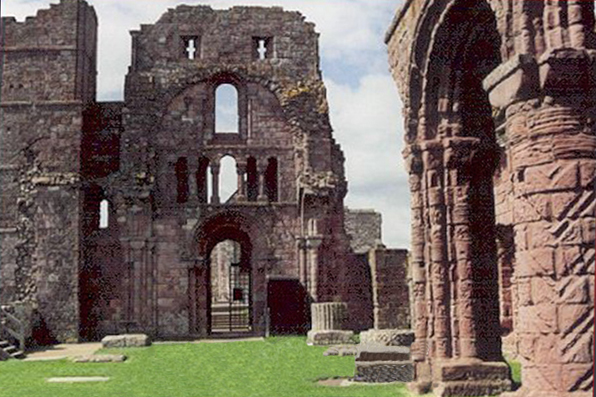"Here Beorhtric [king of Wessex, AD 786-802] took King Offa's daughter Eadburh. And in his days there came for the first time 3 ships; and then the reeve rode there and wanted to compel them to go to the king's town, because he did not know what they were; and they killed him. Those were the first ships of the Danish men which sought out the land of the English race."
Anglo-Saxon Chronicle
This is the entry for AD 789, written by the chronicler a hundred years later. Almost two centuries later still, Ęthelweard, a descendant of King Alfred's brother Ęthelred and ealdorman of Wessex, wrote his own Chronicle, a Latin translation of a lost version of the Anglo-Saxon Chronicle that elaborates on the momentous event. "Suddenly there arrived on the coast a fleet of Danes, not large, but of three ships only" (III). Assuming the strangers to be traders, the king's reeve, accompanied by several men, sought to escort them to the royal manor at Dorchester (on the southwestern coast of England). But they were killed on the spot.
For AD 793, there is another, more ominous entry in the Anglo-Saxon Chronicle.
"Here terrible portents came about over the land of Northumbria, and miserably frightened the people: these were immense flashes of lightening, and fiery dragons were seen flying in the air. A great famine immediately followed these signs; and a little after that in the same year on 8 June the raiding of heathen men miserably devastated God's church in Lindisfarne island by looting and slaughter."
The next year, there was an attack on the Northumbrian monastery at Jarrow, where Bede had composed his Ecclesiastical History of the English People, and the year after that, on St. Columba's monastery on the island of Iona in the west. These were the first in a series of Viking raids that ravaged the island until the Treaty of Wedmore in AD 878, when a victory by King Alfred preserved Wessex along the southern coast of England and restricted the Danes to an area of influence under the Danelaw.
The Vikings attack on the monastery of St. Cuthbert on the holy island of Lindisfarne off the northern coast of Northumbria mark the earliest recorded and the best known of the Viking raids. One of the most holy sites in Anglo-Saxon England, it had been founded in AD 635 by Aidan, an Irish monk summoned by King Oswald to be the first bishop of Bernicia, the northern part of his kingdom. The priory church was constructed in the mid-twelfth century to mark the place where Cuthbert's coffin had been buried, the incised pillars of the nave deliberately evoking those of Durham, where the saint's body was interred.
For more than a century and a half, Lindisfarne had been a sanctuary of learning. It was here that the Lindisfarne gospels had been copied and illuminated, the monastery a repository for riches bequeathed by both the pious and the wicked for the repose of their souls. In its chapels and on its altars were golden crucifixes and crosiers, silver pyxes and ciboria, ivory reliquaries, and tapestries. In its scriptorium, illuminated manuscripts.

"Out of the north an evil shall break forth upon all the inhabitants of the land."
Jeremiah I.14
The attack on Lindisfarne was unprecedented and horrified those who wrote of it. For Alcuin, who was at the court of Charlemagne and a leader of the Carolingian Renaissance, it was inconceivable that ships could suddenly appear from over the horizon.
"Lo, it is nearly 350 years that we and our fathers have inhabited this most lovely land, and never before has such terror appeared in Britain as we have now suffered from a pagan race, nor was it thought that such an inroad from the sea could be made. Behold, the church of St. Cuthbert spattered with the blood of the priests of God, despoiled of all its ornaments; a place more venerable than all in Britain is given as a prey to pagan peoples."
Alcuin, Letter to Ethelred, King of Northumbria
Another chronicler, also working from a lost version of the Anglo-Saxon Chronicle but writing in the twelfth century, tells of that fateful year.
"In the same year [AD 793] the pagans from the northern regions came with a naval force to Britain like stinging hornets and spread on all sides like fearful wolves, robbed, tore and slaughtered not only beasts of burden, sheep and oxen, but even priests and deacons, and companies of monks and nuns. And they came to the church of Lindisfarne, laid everything waste with grievous plundering, trampled the holy places with polluted steps, dug up the altars and seized all the treasures of the holy church. They killed some of the brothers, took some away with them in fetters, many they drove out, naked and loaded with insults, some they drowned in the sea..."
Simeon of Durham, Historia Regum (LVI)
So terrible was the attack on God's house that Alcuin sought to justify its occurrence (just as, over two hundred years later, Wulfstan, archbishop of York, would admonish his English brethren for their sins when renewed raids by the Danes had forced King Æthelred to flee to Normandy). How else to explain these depredations except that an omnipotent God was deservedly chastising an unworthy people with acts of divine retribution.
"the calamity of your tribulation saddens me greatly every day, though I am absent; when the pagans desecrated the sanctuaries of God, and poured out the blood of saints around the altar, laid waste the house of our hope, trampled on the bodies of saints in the temple of God, like dung in the street.... What assurance is there for the churches of Britain, if St Cuthbert, with so great a number of saints, defends not its own? Either this is the beginning of greater tribulation, or else the sins of the inhabitants have called it upon them. Truly it has not happened by chance, but is a sign that it was well merited by someone. But now, you who are left, stand manfully, fight bravely, defend the camp of God."
Wulfstan, Letter to the Bishop of Lindisfarne
Indeed, this scene of Viking marauders brandishing swords and battle axes that decorates the head piece of a gravestone at Lindisfarne (above) does suggest an impending Day of Judgment.
Even though the chroniclers identify the raiders as Danes, the term, like Northmen or Norsemen, was used generically to signify all Scandinavian invaders. In fact, the early Vikings tended to be Norwegian, but it was from the Danes, who began their pillaging in AD 835, that the English suffered the most. With their defeat by Alfred at the Battle of Edington in AD 878, the Treaty of Wedmore later that year established the Danelaw, with Wessex free of further attack but the country to the north and east of Alfred's kingdom subject to Danish law.
References: The Anglo-Saxon Chronicle (1996) translated and edited by Michael Swanton; English Historical Documents c.500-1042 (1979) edited by Dorothy Whitelock; The Chronicle of Ęthelweard (1962) edited by A. Campbell; Early Britain: The Cambridge Cultural History (1988) edited by Boris Ford; The Oxford Illustrated History of Medieval England (1997) edited by Nigel Saul; The Illustrated Bede (1989) by John Marsden; The Making of England: Anglo-Saxon Art and Culture, AD 600-900 (1991) edited by Leslie Webster and Janet Backhouse; The Fury of the Northmen: Saint, Shrines and Sea-Raiders in the Viking Age, AD 793-878 (1995) by John Marsden; Lindisfarne Priory and Holy Island (1988) by Eric Cambridge (English Heritage).
